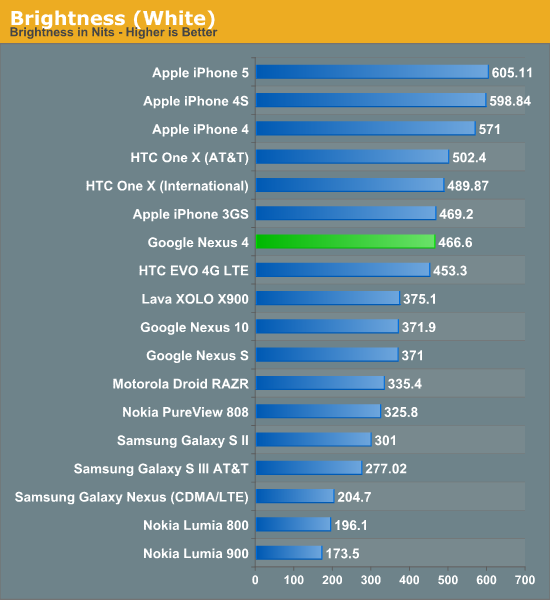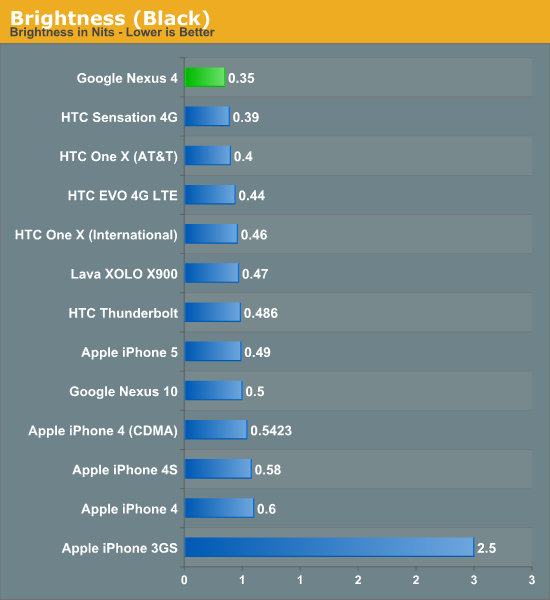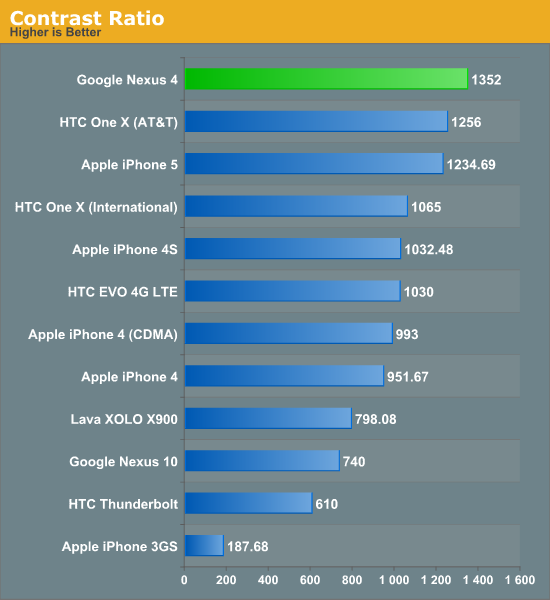Google Nexus 4 Review - Google's new Flagship
by Brian Klug on November 13, 2012 8:45 AM EST- Posted in
- Smartphones
- LG
- Android
- Mobile
- APQ8064
- Nexus 4
- Android 4.2
- MDM9215
The display on the Nexus 4 is another shared component between the Optimus G, and is a 4.7-inch IPS WXGA (1280x768) LCD, which is of course home to an RGB stripe and in-cell touch, or as LG calls it, "zerogap" touch. LG Display unsurprisingly knows how to make LCD displays, and the Nexus 4 display looks subjectively very good. At 320 PPI I can’t see any pixels, and don’t think we need to get into the whole visual acuity discussion again, it’s very good on the Nexus 4. The added width over straight 720p is something I noted was actually very refreshing on the Optimus G when playing with that device in Korea. Most apps scale appropriately and take advantage of it without any issue, and the extra width definitely is noticeable in Chrome, Plume, and all my daily drivers.



The Nexus 4 display goes very bright, at 466 nits, and achieves a contrast ratio of 1352:1 at that maximum brightness setting. This is a huge step over the barely 200 nits that the Galaxy Nexus could eek out.
| CalMAN Display Comparison | |||||||||
| Metric | iPhone 5 | iPhone 4S | HTC One X | Samsung Galaxy S 3 | Samsung Galaxy Note 2 | Google Nexus 4 | |||
| Grayscale 200nits Avg dE2000 | 3.564 | 6.162 | 6.609 | 4.578 | 5.867 | 7.686 | |||
| CCT Avg (K) | 6925 | 7171 | 5944 | 6809 | 7109 | 8506 | |||
| Saturation Sweep Avg dE2000 | 3.591 | 8.787 | 5.066 | 5.460 | 7.986 | 8.517 | |||
| GMB ColorChecker Avg dE2000 | 4.747 | 6.328 | 6.963 | 7.322 | 8.185 | 7.531 | |||
I’ve mentioned that Google continues to struggle at calibrating their displays. The truth is that everyone except for Apple, HTC, and occasionally Samsung, struggle at calibrating mobile displays. This continues to be the case with the Nexus 4, and the result is that accuracy could be better. I’m convinced the results that we’re getting out of the Nexus 4 basically represent no attempt at calibrating the display, and as a result the numbers suffer.
















188 Comments
View All Comments
dishayu - Wednesday, November 14, 2012 - link
Meh, that is how they statistically show you that thermal throttling is affecting the performance. Your accusation would have help good if they had only published the freezer benchmarks. But they published both because they wanted to showcase that the phone thermally throttles itself (i.e. a negative point about the phone)... How exactly is that partial?kgh00007 - Monday, November 19, 2012 - link
I think it is particularly significant that this phone was selected to be the first phone that was actually put in a freezer and the results published, why not the iPhone or some other phone that was known to be trottling?Seriously, think about it.
There is a big difference between stating that a phone throttles and the theoretical performance is X and actually putting a phone in the freezer and publishing the resulting benchmarks.
I am entitled to my opinion, and my opinion here is that somebody is working for the man, the wrong man.
kgh00007 - Monday, November 19, 2012 - link
There is quite a big difference between stating that a phone is throttling and the theoretical performance should be X, and putting a phone in the freezer and publishing the resulting benchmarks.The choice of phone to be the first to recieve this treatment is suspicious to me.
My opinion, which I am entitled to, is that somebody is working for the man, the wrong man.
This is evident to me, think about it yourself.
thesavvymage - Wednesday, November 14, 2012 - link
they basically said "the phone IS being thermally throttled. here's what would happen if it wasnt..."nowhere does it ever say that the freezer tests would ever be indicative of a real world test. they are just showing for information
kgh00007 - Monday, November 19, 2012 - link
People are aready taklking in the comments about how this phone has to be put in the freezer in order to gain maximum performance from it.People are not saying the same about the iPhone, that is the significance.
As I said something fishy going on here and I don't like it.
In fact this is the first time Anandtech has dissapointed me with a review, but it is a rather large dissapointment.
galtma - Wednesday, November 14, 2012 - link
Is it feasible to replace the RAM in the N4 to upgrade it to 32gb? Where in the internals would you dig?noblemo - Wednesday, November 14, 2012 - link
I think you are referring to the NAND Flash, but in either case the NAND and RAM are soldered to the mainboard. Brian made the following comment in the section, "Inside the Nexus 4" (page 7 of the review) regarding the NAND:"I couldn’t get the can off of what appears to be the eMMC (the only remaining large package), we’ll have to see if anyone else wants to do some destructive digging to get that one."
He is referring to the device under the EMI shield (with a QR code label) in the lower left corner of this image:
http://images.anandtech.com/galleries/2435/Nexus-4...
praveen44 - Wednesday, November 14, 2012 - link
Excellent review.spiritrajat - Wednesday, November 14, 2012 - link
most exhaustive review..being an electronics engg myself i realy enjoyed going through the reveiw...job very well donenoblemo - Wednesday, November 14, 2012 - link
Q: Hey, Nexus 4, why so blue?A: Because no one at Google is responsible for display calibration.
It's unfortunate that color accuracy does not get more attention from manufacturers.
Was throttling observed and was there a noticeable impact during daily usage? Any thoughts on whether it would be an issue in climates with ambient temperatures greater than 30C?